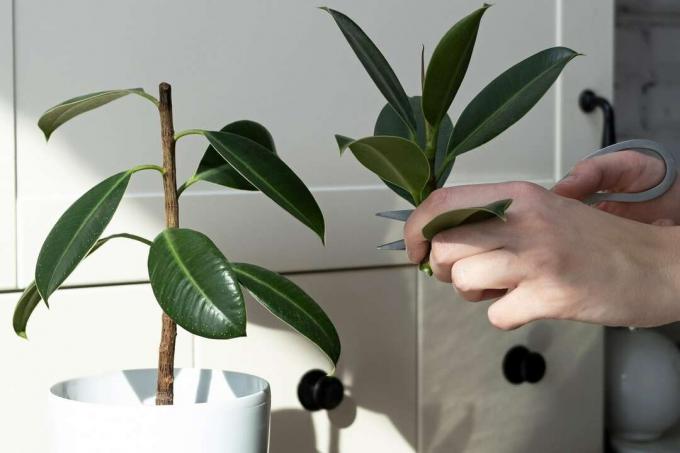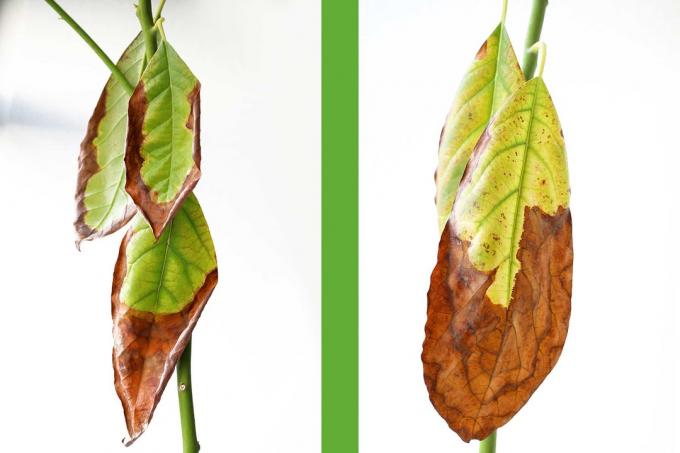

Table of contents
- win offshoots
- gain cuttings
- Gain offshoots with stem
- Plant
- substrate & soil
- watering and fertilizing
- Location
- Conclusion
Only one rubber tree is usually not enough for lovers of this decorative plant. But the houseplant, which belongs to the genus Ficus Elastica, is easy to propagate. If the tree has become too big for the apartment and has grown too high, it must be cut back. This cut can be used as a cutting for a new tree. But even if no pruning is to take place, individual new shoots can be used in spring to propagate the popular, evergreen plant.
win offshoots
If you want to propagate your rubber tree, you usually take cuttings for one or more offshoots that you have previously separated from the tree. This is the easiest way to grow a cutting and, if desired, get many new plants of the popular Ficus Elastica. Because this method is simple and safe, since most of the cuttings take root and new offshoots are created. The right time to obtain the offshoots:
- in the spring when the new shoots appear
- these are broken by hand
- all year round when a mother plant has grown too large
- simply clip the trunk at the desired height
- do not dispose of the cut tip but use it as an offshoot
Tip:
Pruning the trunk does not damage the rubber tree, because new shoots quickly form below the cut points and cover them. Cover the cut with tree wax to allow the wound to heal.
gain cuttings
If cuttings are to become offshoots, then you should opt for beautiful, straight shoots so that the offshoot can grow straight from the start. The shoots, on which a new leaf should already be growing, can simply be removed by hand on the trunk. The sap that is separated out here should be dabbed off carefully on the trunk, and possibly supply the bleeding area with wound wax. The milky liquid on the removed cutting should also be carefully removed with a clean, dry cloth. Proceed as follows with the newly obtained cuttings:
- Place shoot in a glass of water
- always make sure there is enough water
- Leaves should not come into contact with the water
- Ideally place in a warm and bright location
- no direct sunlight,
- otherwise the sheet attached here could burn
- rooting can take up to three months, sometimes even longer
- there may be a week-long standstill in the meantime
- if the leaves on the shoot are green and juicy, the shoot is alive
Tip:
A cutting can also be placed in the ground immediately without roots, but must then always be kept well wet. But rooting does not always succeed in this way and the offshoot withers away. To encourage rooting in the soil, it is increasingly recommended to add cinnamon powder to the stump before planting the cutting. Whether this makes sense, however, has not yet been researched.
Gain offshoots with stem
If the mother tree has grown too large, it must be pruned. This is the right time to acquire a new offshoot that has also already reached a certain height. Rubber trees can reach a height of four meters. If they are prevented from growing in height by the ceiling in the apartment, they simply continue to grow crookedly at the top. To prevent this, the rubber tree can be shortened at the trunk to the desired height. However, it should also be noted that new shoots will develop around the interface, which will also grow quickly. Therefore, the cutting point should be chosen at a height where the rubber tree can be given the opportunity to grow upwards again for a few years. With the rest of the trunk removed, proceed as follows:
- depending on how long the cut off tip is, it can be divided again
- in this way, several offshoots can be obtained
- these are placed in a glass or, depending on their size, in a vase with water
- Avoid contact with water if leaves are present
- keep warm and bright
- after about three months the roots form
- if they are big enough, you can plant
Tip:
If the trunk is cut, only sharp, well-cutting pruning shears that have been disinfected with pure alcohol beforehand should be used. Because if the cut is not smooth but frayed, this can damage the rubber tree. If pruning shears are not disinfected before they are cut, bacteria can adhere to them, which under certain circumstances can get into the cut and damage the plant.
Plant
When strong roots have formed on the cutting after three months, the offshoot can be planted. It makes sense if a glass or a transparent vase was used for rooting, because then the right time can be seen from the outside when the offshoots can go into the ground. The following should therefore be observed when planting:
- when the roots 2-3 cm long can be planted
- use only a small pot for the small offshoot
- create drainage over the drain hole
- use pebbles for this
- plant fleece is placed on top
- Pour half of the soil into the pot
- Insert cuttings very carefully so that the fragile roots are not damaged
- Carefully fill in the rest of the soil and press down lightly
Tip:
Especially the new, small offshoots are still quite susceptible, so they should be regularly checked for spider mites or thrispe and other pests, especially if they are offered an outdoor location becomes.
substrate & soil
Normal potting soil for indoor plants is also suitable for the new offshoot of the Ficus elastica. This is usually also permeated with compost and thus has enough fertilizer in it to ensure the growth of the new plants. Alternatively, garden soil with a peat-sand mixture can also be used here. However, the soil should not be too firm so that the small roots have the opportunity to spread and grow. Otherwise, if the soil is too firm and heavy, the offshoot may not develop further and will wither as the roots are literally crushed by the soil.
watering and fertilizing
If the offshoot was placed in fresh potting soil, then fertilizing is not necessary for the time being, because the fresh soil has enough nutrients to start with. After about three months, however, the new rubber tree can be regularly supplied with a fertilizer for green house plants. When applying fertilizer, the manufacturer's instructions must always be observed, because each form of fertilizer, for example liquid fertilizer or granular slow-release fertilizer, behaves differently. When watering, the following should also be considered:
- the offshoot needs a lot of water at the beginning
- therefore it should be watered regularly
- the soil should always be kept slightly moist
- this can accelerate root growth
- However, waterlogging should be avoided at all costs
- Therefore, half an hour after watering, pour off excess water from the plate
Location
The rubber tree needs a lot of light and brightness to thrive. Therefore, if the cuttings were taken in the spring, this is a good time because the days are getting longer and there is more natural light. When the days get warmer, the cuttings in the vases or glasses filled with water can also be taken outside to a bright but sheltered place. However, night frost should be avoided at all costs. But as a rule, the small containers in which the cuttings are located are quickly placed outside in the morning and returned to the protected interior in the evening. However, direct sunlight should be avoided. If the offshoots have been planted after rooting, the same conditions apply to the ideal location. It should therefore look like this:
- bright and warm
- on warm days in spring on the balcony or terrace
- choose a safe place here
- do not place in direct sun
- if raised in the room, choose the brightest spot in the apartment
- a window sill without direct sunlight is ideal here
Tip:
The growing rubber tree should be rotated frequently. So it does not grow one-sidedly towards the light but develops a straight trunk.
Conclusion
If you already own a rubber tree, you can use it to grow many new small plants via offshoots. It is very easy and also possible for the inexperienced hobby gardener and plant lover to obtain cuttings. A little patience is required here, however, because rooting can take up to three months or more. After this time, however, most offshoots form roots and later develop into a magnificent tree if the few care instructions are followed.
 garden editorial
garden editorial I write about everything that interests me in my garden.
Learn more about houseplants

Avocado Leaves Turning Brown: 8 Common Causes
The avocado is a real nutrient bomb and is considered a so-called superfood, even if there is still no consensus as to whether it belongs to vegetables or fruit. In this country it is mainly cultivated as a decorative houseplant.

Properly multiply ornamental asparagus | Tips for Asparagus densiflorus
The ornamental asparagus, better the ornamental asparagus species Asparagus densiflorus, is considered to be easy to care for - but in many households it dies after a short time. Because the feathered plant has low demands, but these must be met regularly. This is the only way the plant will later reward you with fragrant flowers.

Monstera Gets Brown Spots - What To Do?
The large green leaves of the Monstera bring an exotic flair to the living room at home. Unfortunately, it is not uncommon for brown or black spots to form on the foliage.

Elephant foot: brown tips, loses leaves - 10 effective tips
With its drought tolerance, the elephant's foot is one of the asparagus plants that are not very complicated to care for. Still, some problems such as brown leaf tips can occur if the Ponytail Palm is sited incorrectly or the tree has been watered over.

Rubber tree loses leaves / has no more leaves - that helps now!
Ficus elastica is considered robust and resilient. The helplessness is all the greater when older rubber trees shed their leaves. Various factors can be the cause. In order to save the plants, it is important to stop the leaf loss quickly. A wrong location is not always the trigger for this.

Euphorbia lactea 'Cristata' - care instructions
Not only its unusual appearance, but also the easy care makes the Euphorbia lactea 'Cristata' a popular houseplant in our latitudes. Although the plant is colloquially referred to as a coral cactus, it is actually not a cactus but a combination of two succulents joined together.



